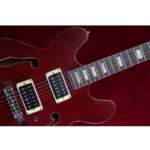Pentatonic scale positions
Have you ever felt lost on the fretboard, struggling to connect your ideas when playing solos? The secret to unlocking your guitar’s full potential lies in mastering pentatonic scale positions. These five simple patterns hold the key to navigating the fretboard effortlessly and creating fluid, expressive solos.
Whether you’re a beginner or a seasoned player, learning to connect pentatonic scale positions will elevate your playing, giving you the freedom to improvise and explore new musical possibilities. Let’s dive into how these patterns work and how you can use them to achieve fretboard fluency.
What Are Pentatonic Scale Positions?
The pentatonic scale consists of five notes, and on the guitar, these notes repeat across the fretboard in distinct patterns. These patterns, known as pentatonic scale positions, overlap and interconnect, forming a complete roadmap from the first fret to the last.
The Five Pentatonic Scale Positions
In any given key, the pentatonic scale is divided into five shapes. For example, in A Minor Pentatonic, the notes A, C, D, E, and G are arranged across these positions:
- Position 1 (Root Note on the Low E String)luaCopy code
e|—————-5–8–|
B|————5–8——|
G|——–5–7———-|
D|—-5–7————–|
A|5–7——————|
E|———————-|
2. Position 2 (Root Note on the A String)
e|—————-8–10–|
B|————8–10——|
G|——–7–9———–|
D|—-7–10————–|
A|7–10——————|
E|———————–|
And so on, for positions 3, 4, and 5. Each position contains the same five notes, just in a different layout.

Download The FretDeck & Pentatonic Secrets Course!
Download Our Course
Why Mastering Pentatonic Scale Positions Is Crucial
1. Unlock the Entire Fretboard
Many guitarists get stuck in one or two scale shapes. By mastering all five positions, you’ll gain access to the entire fretboard, allowing you to move freely between octaves and create dynamic solos.
2. Seamless Soloing
When you know how to connect pentatonic positions, your solos flow more naturally. You’ll no longer feel trapped in a single “box” but can glide effortlessly up and down the neck.
3. Better Improvisation
Understanding scale positions helps you anticipate which notes will sound good, no matter where you are on the neck. This makes improvisation more intuitive and expressive.
4. A Foundation for Advanced Techniques
Pentatonic positions form the basis for advanced concepts like modal playing, hybrid scales, and creative phrasing.
Step-by-Step Guide to Mastering Pentatonic Scale Positions
1. Start with Position 1
Position 1 is the most commonly used pentatonic shape. Practice this shape until it feels second nature. Focus on playing it cleanly and confidently, using alternate picking for precision.
2. Learn Adjacent Positions
Once you’ve mastered Position 1, move to Position 2. Notice how the highest notes of Position 1 become the lowest notes of Position 2. This overlap is what allows you to connect the positions seamlessly.
3. Connect Two Positions
Play Position 1 ascending (low to high) and transition directly into Position 2. Then, reverse the process, descending from Position 2 back to Position 1.
4. Map Out the Entire Fretboard
Gradually add Positions 3, 4, and 5. Visualize how they connect and overlap. It may help to use a fretboard diagram to track where the root notes (A in this case) fall in each position.
5. Practice Horizontal Movement
Most guitarists practice scales vertically (up and down within a single position). To break out of this habit, challenge yourself to move horizontally across the neck. For example:
- Start in Position 1 on the low E string (5th fret) and play up to Position 2.
- Slide into Position 3 as you ascend further, transitioning smoothly between shapes.
Tips for Fretboard Fluency with Pentatonic Scale Positions
- Use a Metronome
Practicing scales with a metronome helps build timing and precision. Start slow, then gradually increase the tempo as you improve. - Play with Backing Tracks
Backing tracks give you a musical context to apply the scale positions. Start with simple blues or rock progressions and experiment with connecting positions in your solos. - Visualize the Root Notes
Root notes are your anchor points when navigating the fretboard. Always know where the root note of the scale is in each position. - Improvise Daily
Set aside time each day to improvise using the pentatonic scale. Focus on connecting different positions and experimenting with bends, slides, and vibrato to make your solos expressive.
Taking It to the Next Level with Pentatonic Scale Positions
Once you’ve mastered the pentatonic scale positions, the next step is to add complexity and flavor to your playing:
- Integrate Major and Minor Pentatonics: Blend these scales to create unique, versatile solos.
- Add the Blues Note: Turn the pentatonic scale into the blues scale by adding the flat 5th for extra tension.
- Explore Advanced Techniques: Try tapping, string skipping, and arpeggios within the pentatonic framework.
Conclusion
Mastering pentatonic scale positions isn’t just about learning shapes—it’s about gaining the freedom to express yourself across the entire fretboard. With consistent practice and creativity, you’ll unlock the true potential of these versatile scales, transforming your solos into works of art.
Call to Action
Want to take your pentatonic mastery further? Check out FretDeck’s Pentatonic Secrets Course for in-depth lessons and exercises designed to help you connect the fretboard like a pro. Don’t forget to join the Guitar Freaks Hangout on Discord to share tips, jam with fellow guitarists, and grow together as a community. Let’s make music! 🎸
- Ultimate Guide to the Pentatonic Scale (Charts, Exercises, FAQ) – This comprehensive guide offers detailed charts and exercises to help you master pentatonic scales across the fretboard.
Internal Link:
- Guitar Fretboard Mastery: Learn the 5 Pentatonic Patterns with FretDeck – Dive into this in-depth article from our blog to learn about the five essential pentatonic patterns and how to integrate them into your playing for complete fretboard fluency.

Download The FretDeck & Pentatonic Secrets Course!
Download Our Course










